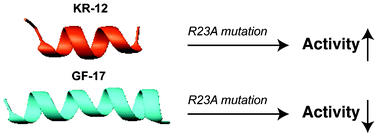Structural location determines functional roles of the basic amino acids of KR-12, the smallest antimicrobial peptide from human cathelicidin LL-37†
Abstract
Cationic antimicrobial peptides are recognized templates for developing a new generation of antimicrobials to combat superbugs. Human cathelicidin LL-37 is an essential host defense molecule in human innate immunity. Previously, we identified KR-12 as the smallest antibacterial peptide of LL-37. KR-12 has a narrow activity spectrum since it is active against Gram-negative Escherichia coli but not Gram-positive Staphylococcus aureus. The functional roles of the basic amino acids of KR-12, however, have not yet been elucidated. An alanine scan of cationic amino acids of KR-12 provided evidence for their distinct roles in the activities of the peptides. Bacterial killing and membrane permeation experiments indicate that the R23A and K25A mutants, as well as the lysine-to-arginine mutant, were more potent than KR-12. Another three cationic residues (K18, R19, and R29) of KR-12, which are located in the hydrophilic face of the amphiphathic helix, appeared to be more important in clustering anionic lipids or hemolysis than R23 and K25 in the interfacial region. While the loss of interfacial R23 or K25 reduced peptide helicity, underscoring its important role in membrane binding, the overall increase in peptide activity of KR-12 could be ascribed to the increased peptide hydrophobicity that outweighed the role of basic charge in this case. In contrast, the mutations of interfacial R23 or K25 reduced peptide bactericidal activity of GF-17, an overlapping, more hydrophobic and potent peptide also derived from LL-37. Thus, the hydrophobic context of the peptide determines whether an alanine substitution of an interfacial basic residue increases or decreases membrane permeation and peptide activity.


 Please wait while we load your content...
Please wait while we load your content...